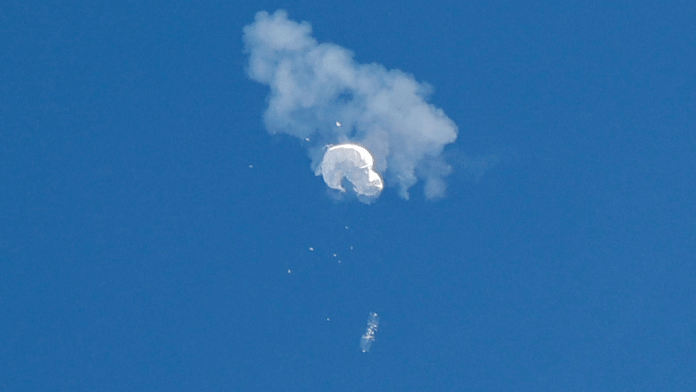New Delhi: The US Department of Defence Sunday confirmed that a fighter jet has shot down a suspected Chinese spy balloon which was seen hovering over sensitive American assets last week.
Shot over the Atlantic, the debris of the balloon was spread over 11 km and fell into 47 feet of water, near Myrtle Beach, South Carolina.
Two fighter jets from Langley Air Force Base attacked the balloon and an F-22 jet fighter brought the high-altitude balloon down six nautical miles off the US coast at 19:39 GMT (1:09 IST), with one Sidewinder air-to-air missile, AIM-9X, a defence official told the The New York Times.
Two naval ships of which one comes with a heavy crane are now working on recovering the debris. Senior US defence officials said that the Pentagon was able to study and scrutinise the balloon and its equipment in detail and that it has been valuable.
“They successfully took it down, and I want to compliment our aviators who did it,” US President Joe Biden said in a statement.
The Chinese foreign ministry expressed “strong dissatisfaction and protest against the US’s use of force to attack civilian unmanned aircraft”. “Under such circumstances, the US insists on using force, obviously overreacting and seriously violating international practice. China will resolutely safeguard the legitimate rights and interests of relevant companies, while reserving the right to make further necessary reactions,” it said.
Also Read: Blinken calls off Beijing visit after Chinese spy balloon spotted. PRC may have used it on India
US-China relations over recent years
US Secretary of State Antony Blinken, who was scheduled to leave for Beijing Friday night as a part of an important diplomatic visit to China, cancelled the trip after the balloon breached American airspace.
Relations between the two countries have been strained for years, with deep mistrust over issues such as trade war tensions, human rights, Taiwan’s autonomy among others. It further worsened after China refused to condemn and defended Russia over its invasion of Ukraine.
The trade war between China and the US began during the Trump era in 2018. Then US President Donald Trump imposed tariffs on roughly $360 billion of Chinese goods, and China retaliated with tariffs on more than $110bn worth American products.
Most recently, the Biden administration is also considering a complete ban on US investment into high-end Chinese tech like AI, quantum computers, 5G, advanced semiconductors among others.
The two countries have also had a difficult relationship over human rights issues, especially regarding China’s mistreatment of Rohingya Muslims. Washington’s diplomatic boycott of the Beijing Winter Olympics in 2022 over the issue had cast a shadow over diplomatic ties. Beijing’s neutrality over the Russian invasion of Ukraine was also seen by Washington as its complicity with Moscow.
US Congressional activism on Taiwan’s autonomy and former speaker of the US House of Representatives, Nancy Pelosi’s visit to Taiwan in August last year, sparked strong reactions from Beijing which saw the trip as a challenge to its sovereignty and territorial integrity.
Despite this tenuous diplomatic relationship, the meeting between Chinese President Xi Jinping and US President Joe Biden in Bali during the G20 summit offered some hope for potential developments in the ties between the two world powers to resume dialogue on various fronts ranging from trade & technology to human rights.
(Edited by Tony Rai)



